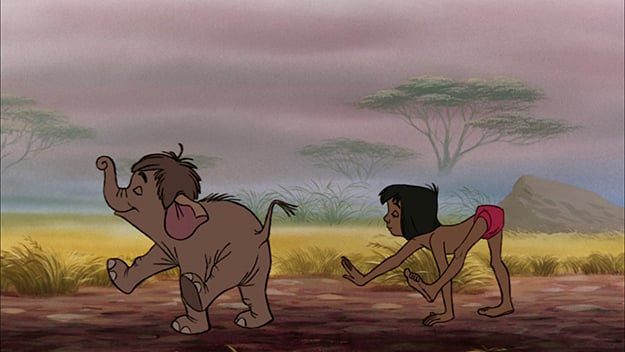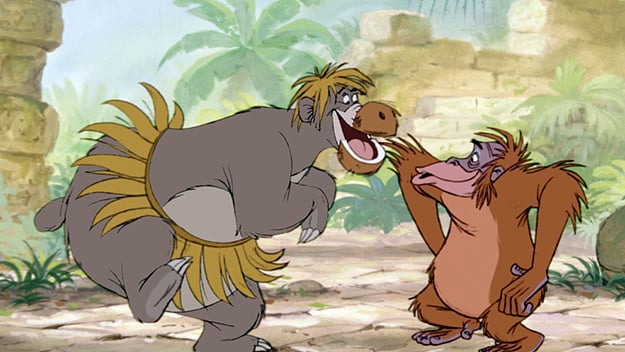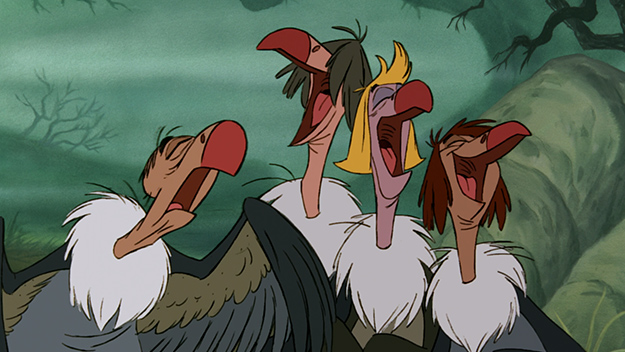Cinema ’67 Revisited: The Jungle Book
In my 2008 book Pictures at a Revolution, I approached the dramatic changes in movie culture in the 1960s through the development, production, and reception of each of the five nominees for 1967’s Best Picture Academy Award: Bonnie and Clyde, The Graduate, In the Heat of the Night, Guess Who’s Coming to Dinner, and Doctor Dolittle. In this biweekly column, I’m revisiting 1967 from a different angle. As the masterpieces, pathbreakers, and oddities of that landmark year reach their golden anniversaries, I’ll try to offer a sense of what it might have felt like to be an avid moviegoer 50 years ago, discovering these films as they opened.

On December 15, 1966, Walt Disney died. By the time of his death, The Jungle Book was in production, and Disney had taken a personal hand in it, expanding the role of Baloo the bear and vetoing an initial script with a downbeat ending (well, downbeat for Disney) and more of a sense of menace and violence than he believed an animated film could then contain. The result, the final movie to bear his personal touch, was therefore something of a last hurrah, if a relatively modest one: the company’s freehanded adaptation of Rudyard Kipling’s 1894 story collection The Jungle Book runs a mere 79 minutes, with half a dozen songs to fill out its very thin story, and it lacks the painterly beauty of the animated features (Pinocchio, Fantasia) from the company’s first golden age. But audiences responded quickly and enthusiastically: by the end of 1967 The Jungle Book was the year’s fourth-highest grosser—a nice comeback from Disney’s previous animated feature, The Sword in the Stone—and its Sherman Brothers score was popular (although the film’s sole Oscar nomination went to the one non-Sherman tune, Terry Gilkyson’s “The Bare Necessities”). It was to be the last major hit for Disney animation for 20 years.
Viewed 50 years later, The Jungle Book isn’t quite good enough to earn a spot alongside the original greats. Animators are said to have been excited about the prospect of working on an array of animals, and the slithering Kaa, Bagheera the panther, the comically low-slung King Louie, the bottom-heavy Baloo, and the terrifying (to a child) tiger Shere Khan are the movie’s visual highlights. But even in a generally positive review, Variety correctly conceded that the film “never [reached] peaks in either drama or comedy.” By today’s standards, Mowgli is an awfully passive hero—he enters a strange world, is buffeted from situation to situation, and then exits, an Alice without the absurdism or the forceful personality.

The Jungle Book has long been politically discomforting, though it tries hard, and mostly successfully, to be less racist than the Kipling source material. Disney’s track record in this area was hardly unblemished, from the jabbering crows in Dumbo to Song of the South, and by the mid-1960s, the company was sensitive enough to nix Louis Armstrong, its own original choice for the voice of the ape King Louie, aware of the minefield of casting a black voice actor in the role; instead, they chose the Italian-American Louis Prima, who gets to sing the slightly problematic, mostly delightful “I Wan’na Be Like You.” (The possibility of casting voice actors of color for the other roles, of course, simply didn’t occur to Disney in 1966.)
Today, the strangeness that feels attached to this movie is more about gender and orientation than about race. The Jungle Book is among the most male of all old Disney cartoons, and it contains enough encoded gay subtext to stock a sequel to The Celluloid Closet. There are virtually no female characters in a narrative that is readable (bear with me) as being largely about a series of gay men vying to be either protectors or destroyers of little lost Mowgli. On the good side, there’s the kind one, Bagheera (voiced by Sebastian Cabot, then well-known to American TV audiences as the prissy “gentleman’s gentleman”-turned-nanny Mr. French on the sitcom Family Affair), and the playful but irresponsible Baloo, who practically has a breakdown when Bagheera tells him he can’t adopt Mowgli. And on the other side of the ledger are the slithering seducers and killers, the menaces to avoid in the playground. After their successes with Maleficent in Sleeping Beauty (1959) and Cruella de Vil in 101 Dalmatians (1961), Disney chose The Jungle Book as the moment to pivot from Wicked Queens to… wicked queens. There’s a direct line from George Sanders’s evil Shere Khan to Jeremy Irons’s Scar in The Lion King (which is in many ways an uncredited point-by-point remake of this film) as well as a host of other plummily accented, silkily evil characters.

In the end, what draws Mowgli out of the jungle and back to the civilized world is, you guessed it, a girl—“Shanti,” who just might be the worst female character in the history of Disney cartoons. Mowgli espies her fetching water and singing a tune called “My Own Home,” in which she forecasts the following future for herself:
I will have a handsome husband
And a daughter of my own
I’ll send her to fetch the water
I’ll be cooking in the home.
Unsurprisingly, “My Own Home” didn’t make the cut for Disney’s 2016 remake.
With that, Mowgli puts away the immature pleasures of the jungle and graduates to his preordained role in the world of men (and ladies). And with that, Disney animation entered 20 years of uncertainty about what a future without its founder might look like. Its half-dozen animated features for the next two decades (which included Robin Hood and The Fox and the Hound) were of varying success; it wasn’t until 1989 that someone at the company thought to make the princess the main character for the first time in 30 years, The Little Mermaid was released, and movie animation was reborn—this time as a multibillion dollar industry.
How to see it: The Jungle Book is available on DVD and Blu-ray.
Mark Harris is the author of Pictures at a Revolution: Five Movies and the Birth of the New Hollywood (2008) and Five Came Back (2014).







